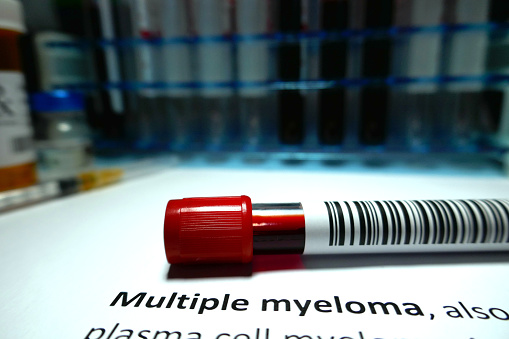
New research has identified characteristic findings of IgD myeloma, which constitutes about 1% of myelomas and has worse prognosis than other subtypes.
In a retrospective review of more than 600 patients with multiple myeloma (MM) over 20 years at the August University Medical Center, the adult teaching hospital affiliated with Medical College of Georgia, Gurnukh Singh, MD, PhD, MBA, Vice Chair of Clinical Affairs for the Department of Pathology at the Medical College of Georgia, and colleagues identified only four patients with the rare IgD MM.
Test findings were consistent in all four patients and are a red flag to physicians that it is likely IgD myeloma and that aggressive treatment is urgently needed, Dr. Singh said in a press release.
One test commonly used in these patients was protein electrophoresis, which enabled Dr. Singh to look in detail at what plasma cells are making based on their unique electrical charge. In all four patients with IgD myeloma, Dr. Singh found multiple bands that reflected both those dysfunctional antibodies and the excessive light chains characteristic of this type of MM, rather than just the single solid band of color that depicts the monoclonal spike. They also consistently indicated more of a specific type of light chain, called lambda, Dr. Singh said.
According to the study, these patients had a mortality rate nearly three times that of patients with other forms of myeloma. There was also higher rates of kidney damage and dialysis among these patients.
IgD-specific testing looks at the heavy chains to give a more complete picture of the disease, Dr. Singh said. He made the analogy of a urine analysis that turns up a gram-negative bacterium. The patient will go ahead and start an antibiotic course but will still be given a test to determine the specific bacterium. Like that test for a specific bacterium, an IgD specific test typically won’t alter, only delay treatment, Dr. Singh said.
Another noteworthy finding was the presence of circulating plasma cells in all patients with IgD myeloma.
The average length of survival from time of diagnosis for these patients was 22 months. When one patient with only a one-month survival was excluded, the average length of survival was 29 months, still markedly shorter than what is seen in patients with IgG and IgA-intact immunoglobulin-producing light chain predominant MMs.
In the study, Dr. Singh proposed the following criteria for a presumptive diagnosis of IgD myeloma:
- Multiple bands on serum protein electrophoresis (SPEP) and serum immunofixation (sIFE) with usual staining for gammopathy, kappa, and lambda. SPEP band representing intact immunoglobulin in the beta or anodal gamma region
- One or more bands in the alpha or beta region or anodal gamma region on sIFE representing monoclonal light chains
- High enough concentration of serum free light chains to meet criteria for light chain predominant MM
- Circulating plasma cells
- Lambda light chain as the involved light chain
- Suppressed levels of IgG, IgA, and IgM
Next steps should include clinical trials comparing patient outcomes when the IgD specific testing is used and when these earlier indicators serve as clues to get started on treatment.
Singh G. Criteria for presumptive diagnosis of IgD multiple myeloma. International Journal of Pathology and Clinical Research. 2022. doi:10.23937/2469-5807/1510125





 © 2025 Mashup Media, LLC, a Formedics Property. All Rights Reserved.
© 2025 Mashup Media, LLC, a Formedics Property. All Rights Reserved.